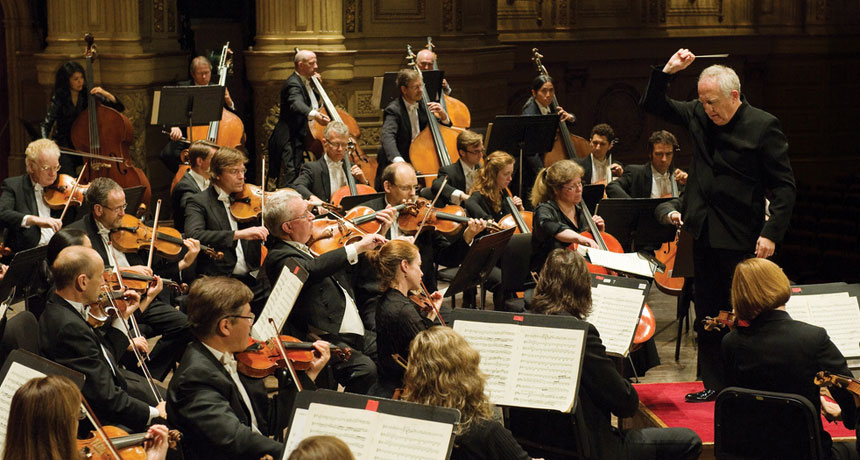Our taste in music may age out of harmony
As we get older, our brains may be less able to discriminate between harmony and dissonance

In music, some notes ring together in beautiful harmony, while others rattle against each other. Our brains process consonance and dissonance differently, but the differences decrease as we grow older.
Vancouver 125/Wikimedia Commons (CC BY 2.0)
- More than 2 years ago
Music displays all the harmony and discord the auditory world has to offer. The perfect pair of notes at the end of the Kyrie in Mozart’s Requiem fills churches and concert halls with a single chord of ringing, echoing consonance. Composers such as Arnold Schönberg explored the depths of dissonance — groups of notes that, played together, exist in unstable antagonism, their frequencies crashing and banging against each other. Dissonant chords are difficult to sing and often painful to hear.
But they may get less painful with age.
As we age, our brains may lose the clear-cut representations of these consonant and dissonant chords, a new study shows. The loss may affect how older people engage with music and shows that age-related hearing loss is more complex than just having to reach for the volume controls.
The main mechanism behind age-related hearing loss is the deterioration of the outer hair cells in the cochlea, a coiled structure within our inner ear. When sound waves enter the ear, a membrane vibrates, pulling the hair cells to and fro and kicking off a series of events that produce electrical signals that will be sent onward to the brain. As we age, we lose some of these outer hair cells, and with them goes our ability to hear extremely high frequencies.
Another process also decreases with age: Temporal coding, the timing at which individual or groups of brain cells fire. Auditory neuroscientists Oliver Bones, of the Chinese University of Hong Kong, and Christopher Plack, of the University of Manchester in England, examined how temporal coding changes with age, and what that means for our perception of musical tones.
The scientists previously showed that this timing of neuron firing within the brain stem was associated with how people perceive consonant pairs of musical notes — harmonious and generally pleasing — or dissonant ones, which can be harsh and tense. The researchers reasoned that if temporal coding in the brain stem declined with age, the ability to distinguish consonance from dissonance might decrease as well.
Consonance vs. dissonance
In a new study, researchers tested how people perceive consonant pairs of musical notes, which are harmonious and generally pleasing, or dissonant ones, which can be harsh and tense.
This is a a consonant chord, what’s called an open fifth:
And here’s a dissonant pair, called an augmented fourth, or tritone:
Credit: O. Bones
Their new study included 28 participants under age 40 and 16 participants over 40. In one test, participants ranked pairs of notes played together on a scale of “very unpleasant” to “very pleasant.” They heard chords ranging from what’s called a minor second — two clashing notes only a half step apart on the scale — to the consonant perfect fifth — the first and fifth notes of a traditional seven-note scale — with all the two-note chords in between.
In a second experiment, Bones and Plack recorded the participants’ neural responses within the brain stem while they heard a consonant or dissonant chord. They used a technique called frequency-following response, which measures the response of a group of neurons to a sound stimulus such as a musical chord.
In young people, there was a sharp distinction in temporal coding in response to the two different types of chords. But this sharply defined timing became fuzzier with age: Older subjects did not distinguish as sharply between consonant and dissonant chords, the researchers report March 4 in the Journal of Neuroscience.
And that may explain a result from the first experiment: Older participants rated dissonant chords as less unpleasant than did younger people. They also rated consonant chords as less pleasant.
Even though these dissonant tones might seem unpleasant for young folks, Bones notes we probably can’t really enjoy music without them. He explains that we know a chord is dissonant only because it sounds different in comparison to a consonant chord. And that if you don’t have a perfect fifth to compare to a minor second, neither chord would sound as interesting — or, possibly, as musical. “If you didn’t have a sense of consonance you wouldn’t enjoy the dissonance,” he says. “It’s not that one is better.”
The results show that age-related hearing loss goes deeper than the loss of the hair cells in the inner ear. “As we age and temporal coding in the brain declines, this might be the cause of older listeners being less sensitive to the difference between consonant and dissonant chords,” says Nina Kraus, an auditory neuroscientist at Northwestern University in Evanston, Ill. She says a deterioration in the ability to distinguish these chords “might lead also to older listeners tending to engage less with music.”
The participants in this study were nonmusicians, people who had had no musical training in at least the last five years. Kraus says that “it would be extremely interesting to see whether older musicians would also show a decline in both consonant preference and neural encoding.”
But there’s a lot more to musical enjoyment than an ability to distinguish chords. Just because older people might not be able to process the chords as clearly doesn’t mean they can’t enjoy the music. “A lot of what we like is the music we imprinted on in adolescence,” says Jennifer Tufts, an audiologist at the University of Connecticut in Mansfield. “My gut feeling is that those kinds of choices are influenced at a much higher level, a much higher cognitive level drawing on personality and training.” If you liked Jimmy Buffet before, you’ll probably still like him when you’re older. Hearing may change, but taste stays the same.
iframe {min-width:100%!important;}





